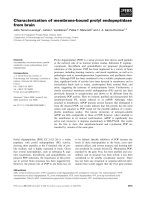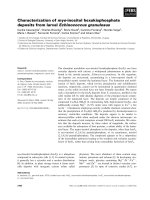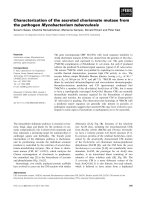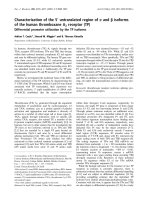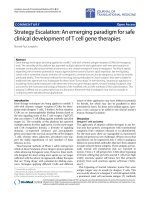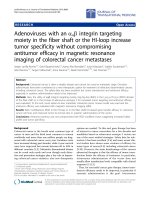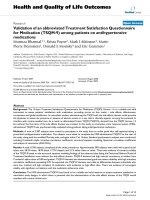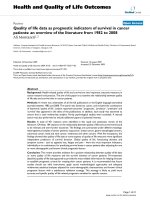Báo cáo hóa học: " Characterization of an Egyptian Spodoptera littoralis nucleopolyhedrovirus and a possible use of a highly conserved region from polyhedrin gene for nucleopolyhedrovirus detection" potx
Bạn đang xem bản rút gọn của tài liệu. Xem và tải ngay bản đầy đủ của tài liệu tại đây (799.8 KB, 11 trang )
BioMed Central
Page 1 of 11
(page number not for citation purposes)
Virology Journal
Open Access
Research
Characterization of an Egyptian Spodoptera littoralis
nucleopolyhedrovirus and a possible use of a highly conserved
region from polyhedrin gene for nucleopolyhedrovirus detection
AlaaEddeen M Seufi
Address: Department of Entomology, Faculty of Science, Cairo University, Giza, 12211, Egypt
Email: AlaaEddeen M Seufi -
Abstract
An Egyptian isolate of Spodoptera littoralis nucleopolyhedrovirus (SpliNPV) was tested for its
potential as biocontrol agent in comparison to Autographa californica multiple nucleopolyhedrovirus
(AcMNPV). Comparative assays of SpliNPV and AcMNPV against 2
nd
instar larvae of Spodoptera
littoralis revealed 4-fold greater susceptibility of S. littoralis to AcMNPV than to SpliNPV based on
LC
50
values for the two viruses. The LT
50
s determined for SpliNPV and AcMNPV using LC
50
of the
virus against 2
nd
instar larvae were 4.2 and 5.8 days, respectively. A DNA segment of 405 bp
containing highly conserved region from polyhedrin gene of SpliNPV (Polh-cr) was successfully
amplified by PCR. Subsequently, this DNA segment was cloned and sequenced. Nucleotide
sequence and its deduced amino acid sequence were compared to all available sequences in
GenBank. Sequence alignment results revealed that Polh-cr showed significant similarities with 91
different baculovirus isolates. The percentage of homology ranged from 78% for Plusia orichalcea
NPV to 99% for SpliNPV. This highly conserved region provides a candidate that could be used in
easy, fast and economic prospective systems for virus detection as well as in biological control
strategies.
Introduction
Baculoviruses are considered to be the largest and most
broadly studied insect viruses. Although they infect over
600 species of insects [1], individual isolates normally
show a limited host range and infect only closely related
species. It is believed that baculoviruses are potentially
useful as safe biological control agent and in some cases
they were used successfully to control different insect
pests [2-4]. However the overall use of baculoviruses for
biological control is limited compared to other pest con-
trol means [3,5]. This is due to the virulence and speed of
action, as related to dose, host range, cost of production
and patent registration are important effectiveness-deter-
mining properties of insect-pathogenic biocontrol agents.
Baculoviruses were not only isolated from the insect
orders Hymenoptera, Diptera and Trichoptera, but also
were isolated from the crustacean order Decapoda
(shrimps) [6]. Furthermore, some NPVs (Penaeus mono-
don-NPV) are considered as serious pests for marine crus-
taceans [7]. The infection of marine crustaceans (shrimps,
prawns, crabs, eustacosa etc.) with NPV will reduce their
economic value and thus negatively affecting the
national income. This problem will arise in countries that
depend on marine wealth as a source of national income
and/or where marine crustaceans are a major in most of
the peoples' food (Australia and Far East nations like
Japan, China, etc ). Although, the shrimp viruses have
now been classified as Nimaviridae in the genus Whispovi-
Published: 23 January 2008
Virology Journal 2008, 5:13 doi:10.1186/1743-422X-5-13
Received: 18 October 2007
Accepted: 23 January 2008
This article is available from: />© 2008 Seufi; licensee BioMed Central Ltd.
This is an Open Access article distributed under the terms of the Creative Commons Attribution License ( />),
which permits unrestricted use, distribution, and reproduction in any medium, provided the original work is properly cited.
Virology Journal 2008, 5:13 />Page 2 of 11
(page number not for citation purposes)
rus and are no longer baculoviruses [8], their diagnosis by
PCR using primers of the polyhedrin and DNA polymer-
ase genes of Autographa californica nucleopolyhedrovirus
(AcMNPV) and Lymantria dispar nucleopolyhedrovirus
(LdMNPV) was confirmed by Hsu et al. (2000). For the
above mentioned reasons, many authors were interested
in developing an accurate and easy diagnostic method to
detect baculoviral infection in larval shrimps as well as
insects [9-13,7,14-19].
Because baculoviruses are of great interest and utility to a
large cross-sections of agricultural and biomedical
research community, selection of some isolates with nat-
ural improved characteristics and definitive characteriza-
tion of them have appeared recently. Consequently this
piece of work will help in viral epidemiology, in moni-
toring the viral dissemination after field application and
in risk assessment studies.
Therefore, the main objective of the present work is to
obtain a sequenced highly conserved DNA fragment from
our NPV isolate to be used in an easy, fast and economic
prospective system for virus detection. Also, this DNA seg-
ment can be used for developing kits of ELISA, hybridiza-
tion, Western and dot blotting. Furthermore, our NPV
isolate may be useful as potential biocontrol agent in pro-
grams of integrated pest management (IPM).
Methods
Insects
Laboratory colony of the cotton leaf worm, Spodoptera lit-
toralis, was originally collected from Giza, Egypt and
maintained in the insectary of Agricultural Genetic Engi-
neering Research Institute (AGERI) under highly control-
led conditions from 1990 to date. The colony was
maintained in the laboratory according to the technique
described by El-Defrawi and coworkers [20]. Larvae were
reared on a semisynthetic diet described by Levinson and
Navon [21]. This colony was kept at 25 ± 2°C, 65–70%
RH and natural photoperiod. These insects were used for
viral propagation and bioassays.
Viruses
An NPV isolate was selected from thirteen Egyptian bacu-
lovirus isolates from different geographical localities dur-
ing 1996–2000. This isolate was studied in detail to
determine its insecticidal activity compared to AcMNPV.
In addition, a highly conserved region of polyhedrin gene
was amplified, cloned and sequenced for further investi-
gations. The selected isolate was collected from an Egyp-
tian field located at Khorshid, Alexandria. It was isolated
during Jan, 1999 from a S. littoralis larva on cabbage
plants. This isolate was successfully propagated, purified
following the method described by Lacey and coworkers
[22] and used for further studies.
A virus stock of NPV from Autographa californica nuclear
polyhedrosis virus (AcMNPV; E
2
strain) was originally
obtained from Prof. Dr. Suzanne Thiem, Department of
Entomology, University of Michigan, was used in the bio-
assays as a reference in comparison to our isolate.
Insecticidal activity
Laboratory bioassay tests were conducted using highly
purified virus suspensions. The SpliNPV and AcMNPV iso-
lates were tested against 2
nd
larval instar from the virus-
free rearing culture in the laboratory. The concentrations
were measured using Thoma haemocytometer and light
microscope [22]. Bioassays were performed using five
concentrations of each virus isolate. Tested larvae were
starved for 8 hours prior to feeding viruses. Serial dilu-
tions of each tested isolate were prepared beginning with
the following stock concentrations in PIB/ml: 7.8 × 10
4
and 9.4 × 10
4
for SpliNPV and AcMNPV, respectively. Bio-
assays were carried out in plastic cups measuring 15 cm
diameter × 10 cm height and containing a layer of 1 cm
semi-synthetic diet. The viral suspensions were dispersed
on the diet using micropipette (25 μl suspension/larva).
Forty larvae were used for each concentration of virus and
control. The control larvae were fed on diet treated with
distilled water. All treatments were kept at 25 ± 2°C and
normal photoperiod. The experiment was replicated
thrice for each virus isolate and control. Mortality was
recorded on the 7
th
day post-infection then corrected
according to Abbott's formula [23]. Cumulative mortality
was recorded daily and the experiment was stopped on
day 10 post-infection. Mortality was corrected according
to Abbott's formula [23].
Statistical analyses
Probit analysis of mortality data from bioassays was con-
ducted using SPSS (ver10.0) computer software (SPSS for
Windows, SPSS Inc., 1997). The LT values for the tested
isolates were derived from analysis of data on the progres-
sion of mortality of S. littoralis larvae, following exposure
to the LC
50
s dosage using probit analysis modified for
multiple observations over time [24] and Mathematica
software (Wolfram, Champaign, IL).
PCR amplification
PCR amplification was performed according to Saiki and
coworkers [25] with minor modifications. Total DNA was
extracted from the NPV isolate and the DNA segment was
amplified using two primers designed based on conserved
nucleotide sequences of ten different polyhedrin genes
[26]. The forward primer: GG(GT) CC(GT) GGC AAG
AAT CAG AA and the reverse one: GCG TC(TG) GG(TG)
GCG AAC TCT TT(TG) ATT TT. Total reaction volume was
50 μl which contained 1× PCR buffer (Promega), 1.5 mM
MgCl
2
, 200 μM dNTPs, 2.5 U Taq DNA polymerase
(Promega), 100 ng of each primer and 30 ng of template
Virology Journal 2008, 5:13 />Page 3 of 11
(page number not for citation purposes)
DNA. The amplification program used was 3 min at 94°C
(hot start), 1 min at 94°C, 2 min at 55°C and 2 min at
72°C for 35 cycles followed by one cycle of 72°C for 7
min. PCR amplification was carried out in a DNA thermal
cycler (Model 380 A, Applied Biosystems, CA, USA).
Cloning of a highly conserved region from SpliNPV
polyhedrin gene
The positive PCR products were visualized and eluted
from the gel using GenClean Kit (Invitrogen Corporation,
San Diego, CA, USA) as described by the manufacturer.
The purified PCR products and a pGEM-T vector (Promega
Corporation, Madison, WI, USA) were mixed in a 5: 1
(insert: vector) molar ratio and ligated using T
4
DNA
ligase (as described by the manufacturer). Ligation mix
was used to transform competent Escherichia coli JM
109
cells (Stratagene, La Jolla, CA, USA). White colonies were
screened using PCR as described earlier in this section.
Nucleotide sequence and sequence analysis
Only one clone pGNPV-95 was selected and sequenced
using M
13
universal forward and reverse primers. Sequenc-
ing was performed using T
7
SequencingT
M
kit (Pharmacia,
Biotech) and model 310 automated sequencer (Applied
Biosystems, Foster City, CA, USA). Analysis of nucleotide
and deduced amino acid sequences was carried out using
EditSeq-DNAstar Inc., Expert Sequence Analysis software,
Windows 32 Edit Seq 4.00 (1989–1999) and ExPasy data-
base on the internet. Blast search for alignment of the
obtained sequence with the published ones was done
using database of National Centre for Biotechnology
Information (NCBI). The cloned DNA fragment (Polh-cr)
was deposited in GenBank under the AY442260
accession
number.
Results
Field survey
During the present study, the most promising isolate, as a
biocontrol agent (based on LC and LT values), was
selected from thirteen Egyptian baculovirus isolates.
Through four visits to the location, out of 63 collected S.
littoralis larvae, 18 larvae were diseased (showed symp-
toms of viral infection). The virus was diagnosed using
light microscope, propagated in a S. littoralis laboratory
colony, purified and kept at -80°C for further studies.
Insecticidal activity
Table (1) presents the LC and LT values for the two tested
isolates (SpliNPV and AcMNPV). It is clear that the newly
molted 2
nd
larval instars of S. littoralis were susceptible to
the applied concentrations. Based on LC
50
in PIB/ml, our
SpliNPV isolate was significantly (4-fold) less active (LC
50
= 1.2 × 10
3
) than the reference strain AcMNPV (LC
50
= 3.7
× 10
2
). Although LC
25
and LC
95
of our isolate were
approximately 2 and 8-fold lower than that of AcMNPV,
there were substantial overlap in the 95% confidence lim-
its of the two viruses. Time to death showed some depend-
ence on the initial concentration. Furthermore, it was
observed that the highest peak of mortality was on 4–6
days post-infection. The progression of mortality in 2
nd
instar larvae of S. littoralis over a 10-day-period following
exposure to LC
50
dosage of the two viruses was analyzed
to produce LT values (Table 1). Probit analysis of the LT
values revealed that the decrease in LT values in favour of
our isolate against AcMNPV was not significant. Despite
the overlap in the 95% confidence intervals of the two
viruses, LT
95
of our isolate was nearly 4 days less than that
of AcMNPV (95% c.i. 9.7–25.4 days, X
2
= 2.64, DF = 8, P
= 0.96, slope = 3.49 ± 0.74).
PCR amplification
Two oligonucleotide primers were designed to amplify
537 bp within the open reading frame (orf) of polyhedrin
gene [26] and were successfully used in PCR. PCR analysis
of our results revealed that a DNA fragment of only 405
bp was amplified within the orf (beginning about 78 – 81
codons after the starting codon, AUG) of the SpliNPV-95
polyhedrin gene (Fig. 1, lane 5). Subsequently this DNA
segment was cloned into pGEM-T vector (Fig. 1, lane 2)
and transformed cells were tested with PCR using the
same primers (Fig. 1, lane 6). Using this screening
method, clone pGNPV-95 was tested as positive (Fig. 1,
lane 6).
Table 1: Susceptibility of 2nd instar larvae of S. littoralis to the nucleopolyhedroviruses of A. californica (AcMNPV) and S. littoralis
(SpliNPV)
Isolate LC values in PIB/ml (95% confidence limits) LT values in days (95% confidence limits)
LC
25
LC
50
*LC
95
LT
25
LT
50
LT
95
AcMNPV 19.5
(4.8 – 4.0 × 10)
3.7 × 10
2
(1.9 × 10
2
– 6.7 × 10
2
)
7.5 × 10
5
2.4 × 10
5
– 3.7 × 10
6
)
3.7
(2.50 – 4.59)
5.8
(4.73 – 7.14)
17.2
(12.01 – 39.03)
SpliNPV 39.3
(1.4 × 10 – 8.2 × 10)
1.2 × 10
3
(6.9 × 10
2
– 2.3 × 10
3
)
6.1 × 10
6
(4.5 × 10
5
– 1.9 × 10
7
)
2.6
(1.65 – 3.39)
4.2
(3.26 – 5.17)
13.4
(9.74 – 25.42)
Significant difference at 95% confidence interval
Virology Journal 2008, 5:13 />Page 4 of 11
(page number not for citation purposes)
Nucleotide sequence and sequence analyses
The nucleotide sequence of Polh-cr and its deduced amino
acid sequence are shown in Fig (2). A single open reading
frame (orf) that could encode a polypeptide of 135 amino
acids was detected. No stop codon was found all over the
sequence. This deduced polypeptide contains 16 strongly
basic, 16 strongly acidic, 46 hydrophobic and 34 polar
amino acids. The calculated molecular mass of the puta-
tive polypeptide is 15.92 KDa. Isoelectric point (PI) is
7.242 and the charge at pH 7.0 is 0.331.
The nucleotide sequence of Polh-cr was blasted in Gen-
Bank database and compared to all available sequences.
Alignment results revealed that Polh-cr has significant
alignment with 111 baculovirus isolates (100 NPVs and
11 GVs). The percentage of homology ranged between
99% for SpliNPV (Acc# D01017
) and 78% for Plusia
orichalcea NPV (Acc# AF019882
). Interestingly Polh-cr
produced significant alignments with 11 granulovirus
sequences. This may raise the question of possible homol-
ogous recombination between NPV and GV species.
Comparing Polh-cr nucleotide sequence (Acc# AY442260
)
to its corresponding sequence of AcMNPV (Acc# M25054
)
as a reference, 82% homology, 57 different nucleotides
and 12 gaps were observed throughout the compared
DNA segments (Fig 3).
The deduced amino acid sequence was compared to all
other polyhedrins in GenBank database. Alignment
results showed that the percentage of homology of Polh-cr
ranged between 100% for S. littoralis polyhedrins (Acc#
AAC33752
and AAR04375) and 81% for Attacus ricini pol-
yhedrin (Acc# P31036
).
Agarose gel electrophoresis showing clone pGNPV-95 after linearization with NdeI, and PCR confirmationFigure 1
Agarose gel electrophoresis showing clone pGNPV-95 after linearization with NdeI, and PCR confirmation. Lanes 1 and 2 show
pGEM-T and pGNPV-95 after digestion with NdeI, respectively. Lanes 3 and 4 show Lambda DNA/HindIII Marker. Lanes 5, 6
and 7 show the 405 bp amplified DNA segment from SpliNPV (as positive control), from E. coli harbouring pGNPV-95 and PCR
mix without DNA (as negative control), respectively. The size of the bands is shown in bp.
Virology Journal 2008, 5:13 />Page 5 of 11
(page number not for citation purposes)
On comparing amino acid sequence of the putative
polypeptide of Polh-cr (Acc# AAR04375
) to its corre-
sponding sequences of AcMNPV (Acc# AAA46736
) and
other 4 SpliNPVs (Acc# AAW49208
, BAA00824,
AAT10182
and AAW49207), 15 different amino acids
were observed throughout the compared putative
polypeptides using AcMNPV as a reference (Fig. 4). It is
note worthy to mention that all SpliNPVs amino acid
sequences (Acc# AAW49208
, BAA00824, AAT10182 and
AAW49207
) were identical to Polh-cr putative polypeptide
(Acc# AAR04375
) except for the position 133 (I a.a. was
replaced with V a.a.).
Phylogenetic analyses of Polh-cr
Phylogenetic analyses have been performed on the Polh-cr
nucleotide seuquence and its deduced polypeptide and
results of these analyses are shown in Figs. (5 and 6). In
case of Polh-cr nucleotide seuquence, a phylogenetic tree
was generated from sequence data of 38 NPV isolates by
neighbor-joining distance analysis with maximum
sequence difference 0.75 (Fig. 5). The topology shows
four distinct lineages including 5, 21, 8 and 4 NPV iso-
lates, respectively. The maximum nucleotide sequence
divergence was exhibited in lineage II. Meanwhile, the
NPV isolates appear in the other three lineages as mono-
phyletic sister clades (Fig. 5). In case of Polh-cr deduced
amino acid seuquence, a phylogenetic tree was generated
from sequence data of 102 NPV isolates by neighbor-join-
ing distance analysis with maximum sequence difference
0.75 (Fig. 6). The topology shows three distinct lineages
including 17, 60 and 25 NPV isolates, respectively. The
maximum divergence of amino acid sequences was exhib-
ited in lineage II. However, minimum divergence in case
of the other two lineages was observed. Otherwise, poly-
hedrins from many NPV isolates appear in monophyletic
sister clades (Fig. 6).
Discussion
To date, genetically engineered baculoviruses introduce a
promising research line to overcome the slow action of
baculoviruses as biocontrol agents. On the other hand,
searching for new natural baculovirus isolates with better
insecticidal characteristics is still a developing subject of
work (more safe and has not the risks of releasing geneti-
cally engineered product in nature). Although AcMNPV is
considered as the type species in the genus nucleopolyhe-
drovirus, 15 species and 471 tentative species of NPV have
been isolated [27]. Abul-Nasr [28] isolated an Egyptian
NPV from the cotton leaf worm S. littoralis. Cherry and
Summers [29] isolated the two reference NPV types A and
B. During 1986 – 1988, six natural isolates of SpliNPV
were isolated from Giza, Menya, Kaha, Tokh, Kafr-
Elsheikh and Gharbyia, Egypt (Khamiss, personal com-
munication). Also, fifteen isolates of SpliNPV were iso-
lated from the six above mentioned Egyptian localities in
addition to Fayoum, Sakkara, Menofyia, Benisuef, Asyut,
Sinnuris, Banha, Sharkyia and Elsaff-Giza, Egypt
(Khamiss, personal communication).
Combining our data with that presented by Khamiss and
by Seufi (personal communication), it can be concluded
that 34 NPV isolates have been collected from Egypt
between 1986 and 2000. This may reflect the suitability of
the Egyptian environment for not only gathering and col-
lecting new baculovirus isolates but also for using them as
potential pesticides in integrated pest management (IPM)
programs. Given that baculoviruses have been isolated
from Upper as well as Lower Egypt, in which the cultiva-
tion was washed by chemical insecticides, it would be
expected to find more and more isolates in virgin regions
(where no insecticides were used).
The susceptibility of 2
nd
instar larvae of S. littoralis to the
two polyhedrovirus species reported in this study was
comparable to that observed by Lacey and coworkers [22].
They reported that LC
50
s were 1.77 × 10
3
and 3.05 × 10
3
occlusion bodies (OB)/mm
2
for Anagrapha falcifera (AfM-
NPV) and Autographa californica (AcMNPV) when applied
to the neonate codling moth larvae. Our Egyptian isolate
(SpliNPV) showed similar results to that obtained by
Klein and Podoler against the Egyptian cotton leafworm
[30]. Abot and coworkers [31] clarified that LC
50
s of an
NPV isolate against two A. gemmatalis populations varied
from 129 to 316 OBs/ml diet. Their results fall within the
range obtained with our isolate. On the other hand, our
results showed lower LC
50
when compared with that
reported by Pawar and Ramakrishnan [32] and Komolp-
Nucleotide and corresponding deduced amino acid sequence of a highly conserved region of polyhedrin gene (polh-cr)Figure 2
Nucleotide and corresponding deduced amino acid sequence
of a highly conserved region of polyhedrin gene (polh-cr).
GTGAAGCCCGATACGATGAAGCTGATCGTCAACTGGAACGGCAAAGAG
V K P D T M K L I V N W N G K E
TTTCTCCGTGAGACTTGGACCCGTTTCATGGAAGACAGCTTCCCCATC
F L R E T W T R F M E D S F P I
GTGAACGATCAAGAAGTGATGGACGTGTTTCTAGTGGTGAACATGCGT
V N D Q E V M D V F L V V N M R
CCCACTAGACCGAACCGTTGCTTTAGATTTTTGGCGCAACACGCGCTC
P T R P N R C F R F L A Q H A L
CGATGCGACCCCGAGTACGTTCCCCACGACGTGATCCGCATCGTCGAA
R C D P E Y V P H D V I R I V E
CCGTCGTACGTCGGCACCAACAATGAATACCGCATCAGTCTCGCCAAG
P S Y V G T N N E Y R I S L A K
AAAGGTGGCGGCTGTCCCGTGATGAACCTGCACGCCGAATACACCACT
K G G G C P V M N L H A E Y T T
TCGTTTGAGAGTTTCATCGACAAGGTGATATGGTACAACTTTTACAAG
S F E S F I D K V I W Y N F Y K
CCCATCGTCTACATCGGCACA
P I V Y I G T
Virology Journal 2008, 5:13 />Page 6 of 11
(page number not for citation purposes)
ith and Ramakrishnan [33] whereas LC
50
was 4.677 × 10
6
PIB/ml for 4-day old S. littoralis larvae. Similarly, Ashok
and Ramakrishnan [34] reported higher LC
50
(7.1 × 10
6
PIB/ml) for 3-day old S. litura larvae. Also, Stiles and Him-
merich [35] introduced higher LC
50
of AcMNPV against H.
zea (3.46 × 10
4
– 6.38 × 10
5
PIB/ml). Finally, Abdel-Aziz
(personal communication) presented higher LC
50
s (1.8 ×
10
7
and 9.0 × 10
7
PIB/ml, respectively) for 2
nd
larval instar
of S. littoralis. The variability of LC
50
s is probably due to
the method of surface treatment, homogeneously treated
diet, feeding habit of the insect species [22] or due to dif-
ference in larval age [36,37]. It may also be due to differ-
ence in host susceptibility to NPV [4], number of virions
per occlusion body, virulence of the virus strain and/or
the difference in number of laboratory propagation cycles
for the viral isolate. According to Van-Beek and Huges
[38], the virulence of baculoviruses is best determined by
the speed with which a given virus kills the insect pest.
LT values presented in Table (1) indicated that SpliNPV
killed 2
nd
instar larvae of S. littoralis one day faster than
AcMNPV. In comparing our results with that presented by
other authors, many considerations have to be taken into
account. Host range and LC
95
s of the viral isolates are the
most important considerations. Although LC
95
and LT
95
that produced in this study are economically prohibitive,
improving the insecticidal characteristics of such isolates
(by formulation and synergistic additives) is a growing
subject in many companies.
The full length of polyhedrin gene from lepidopteran
NPVs ranged from 483 bp to 747 bp [39]. In case of poly-
hedrin gene from Spodoptera sp. NPVs, its full length
ranges from 510 bp to 747 bp in comparison to that from
Autographa sp. NPVs which ranges from 507 bp to 738 bp
[39]. Therefore, it could be said that Polh-cr represented
about 65% of the full length of polyhedrin gene. On com-
paring nucleotide sequence of Polh-cr to all available
sequences in the GenBank, it created a significant hom-
ology with 100 NPV and 11 GV genes. It showed 99%
identity with S. littoralis polyhedrin gene (Acc# D01017
),
95% with S. littura polyhedrin gene (Acc# AY552474
) and
93% with S. littura polyhedrin genes (Acc# AY549963
,
AF325155
, AF037262 and AF068189). In addition, it was
Comparison of Polh-cr nucleotide sequence (Acc# AY442260
) to its corresponding sequence of AcMNPV (Acc# M25054) as a referenceFigure 3
Comparison of Polh-cr nucleotide sequence (Acc# AY442260
) to its corresponding sequence of AcMNPV (Acc# M25054) as a
reference. Gaps and different nucleotides are shaded.
SpliNPV 4 AAGCCCGATACGATGAAGCTGATCGTCAACTGGAACGGCAAAGAGTTTCTCCGTGAGACT 63
|||||||| || ||||||||| | || ||||||| |||||||||||||||| | || |||
AcMNPV 1484 AAGCCCGACACCATGAAGCTGGTAGTAAACTGGAGCGGCAAAGAGTTTCTCAGGGAAACT 1543
SpliNPV 64 TGGACCCGTTTCATGGAAGACAGCTTCCCCATCGTGAACGATCAAGAAGTGATGGACGTG 123
||||||||||||||||||||||||||||| ||||||||||| |||||| | |||||||||
AcMNPV 1544 TGGACCCGTTTCATGGAAGACAGCTTCCCTATCGTGAACGACCAAGAAATTATGGACGTG 1603
SpliNPV 124 TTTCTAGTGGTGAACATGCGTCCCACTAGACCGAACCGTTGCTTT-AGATTTTTGGCGCA 182
|| |||||| | |||||| | |||||||| || ||| | || ||| ||||| |||||||
AcMNPV 1604 TTCCTAGTGATCAACATGAGACCCACTAGGCCCAACAGATG-TTTCAGATTCCTGGCGCA 1662
SpliNPV 183 ACACGCGCTCCGATGCGACCCCGAGTACGTTCCCCACGACGTGATCCGCATCGTCGAACC 242
|||||| ||||| |||||||| || |||||||| ||||| || || ||||| || || ||
AcMNPV 1663 ACACGCTCTCCGTTGCGACCCTGACTACGTTCCTCACGAAGTCATTCGCATTGTGGAGCC 1722
SpliNPV 243 -GTCGTACGTCGGCACCAACAATGAATACCGCATCAGTCTCGCCAAGAAAGGTGGCGGCT 301
|| |||||| || | |||||| |||||||||||||| || |||||||| || |||||||
AcMNPV 1723 CGT-GTACGTAGGAAACAACAACGAATACCGCATCAGCCTGGCCAAGAAGGGCGGCGGCT 1781
SpliNPV 302 GTCCC-GTGATGAACCTGCACGCCGAATACAC-CACTTCGTTTGA-GAGTTTCATCGACA 358
| ||| || |||||||| ||| | || ||||| |||| | || || ||||| |||| ||
AcMNPV 1782 G-CCCTGTCATGAACCTTCACTCTGAGTACACGCACTCC-TTCGAAGAGTT-CATCAACC 1838
SpliNPV 359 AG-GTGATATGGTACAACTTTTACAAGCCCATCGTCTAC 396
| || || ||| | ||||| ||||| ||||||||||||
AcMNPV 1839 -GTGTCATCTGGGAGAACTTCTACAAACCCATCGTCTAC 1876
Virology Journal 2008, 5:13 />Page 7 of 11
(page number not for citation purposes)
90% similar to Lymantria dispar polyhedrin genes (Acc#
AF499687
, AF081810 and M23176), 88% to Malacosoma
neustria polyhedrin gene (Acc# X55658
) and 87% to B.
mori polyhedrin genes (Acc# M10043
and X63614). Fur-
thermore, it showed 86% homology with S. litura and
Amsacta albistriga polyhedrin genes (Acc# X94437
and
AF118850
, respectively) and 85% with S. exigua and
Malacosoma neustria polyhedrin gene (Acc# AF169823
;
AY127899
and AJ277555, respectively). These results
ensured that Polh-cr is a highly conserved region within
polyhedrin gene of about one sixth of the known NPV
species. Consequently, it could be used in many molecu-
lar techniques concerned with baculoviruses.
Knowing that the full length of polyhedrin protein from
lepidopteran NPVs ranges from 161 a.a. (e.g. Hyphanteria
cunea NPV, Acc# AAW49190
and Bombyx mori, Acc#
ABB16300
) to 249 a.a. (e.g. Spodoptera litura NPVs, Acc#
AAZ78353
, NP_258269 and AAS90121). In case of Spo-
doptera sp. NPV, full length of polyhedrin protein ranges
from 170 a.a. (Acc# AAW49204
) to 249 a.a. (Acc#
AAZ78353
) in comparison to Autographa sp. NPV which
ranges from 169 a.a. (Acc# AAW63393
) to 246 a.a. (Acc#
AAA46736
). The deduced amino acid sequence of Polh-cr
was compared to other polyhedrins. Alignment results
revealed that Polh-cr was 100% and 99% identical to S. lit-
toralis polyhedrins (Acc# AAC33752
, AAR04375; P24646,
JU0382
and BAA00824, respectively). It was also 99%
similar to S. litura polyhedrins (Acc# NP258269
,
AAC09246
, AAL01689 and AAS58468). In addition, it has
98% identity with polyhedrin of S. littoralis (Acc#
AA590121
). Furthermore, it showed 89% similarity with
polyhedrins of S. exigua and Ecotropis obligua polyhedrins
(Acc# AAF33532
, JQ1868, NP037761, 001586;
AAB53632
, AAQ88174, P07388 and AAA46739).
Using AcMNPV nucleotide sequence (Acc# M25054
) and
amino acid sequence (Acc# AAA46736
) as references for
comparison with our sequences, it was found that 57 dif-
ferent nucleotides and 12 gaps in nucleotide sequence
resulted in 15 different amino acids in the putative
polypeptide (I, N, V, V, E, D, S, T, A, T, S, D, K, Y and I a.a.
from our putative polypeptide were replaced with V, S, I,
I, D, E, V, N, S, H, E, N, R, E and V a.a. from AcMNPV puta-
tive polypeptide, respectively). Surprisingly, Polh-cr puta-
tive polypeptide was identical to SpliNPV polypeptides
(Acc# AAW49208
, BAA00824, AAT10182 and
AAW49207
) with one amino acid replacement (I with V
at the position 133). These results suggested the possible
difference in codon usage among the compared isolates. It
might also give a specific property to our putative
polypeptide.
Comparison of amino acid sequence of the putative polypeptide of Polh-cr (Acc# AAR04375
) to its corresponding sequences of AcMNPV (Acc# AAA46736) and other 4 SpliNPVs (Acc# AAW49208, BAA00824, AAT10182 and AAW49207, respectively)Figure 4
Comparison of amino acid sequence of the putative polypeptide of Polh-cr (Acc# AAR04375
) to its corresponding sequences of
AcMNPV (Acc# AAA46736
) and other 4 SpliNPVs (Acc# AAW49208, BAA00824, AAT10182 and AAW49207, respectively).
The different amino acids were bolded and shaded using AcMNPV as a reference.
SpliNPV
a
: V K P D T M K L I V N W N G K E F L R E T W T R F M E D S F P I V N D Q E V M D V F L
AcMNPV: V K P D T M K LV V N W S G K E F L R E T W T R F M E D S F P I V N D Q E I M D V F L
SpliNPV
1
: V K P D T M K L I V N W N G K E FL R E T W T R F M E D S F P I V N D Q E V M D V F L
SpliNPV
2
: V K P D T M K L I V N W N G K E F L R ET W T R F M E D S F P I V N D Q E V M D V F L
SpliNPV
3
: V K P D T M K L I V N W N G K E F L R ET W T R F M E D S F P I V N D Q E V M D V F L
SpliNPV
4
: V K P D T M K L I V N W N G K E F L R ET W T R F M E D S F P I V N D Q E V M D V F L
SpliNPV
a
: V V N M R P T R P N R C F R F L A Q H A L R C D P E Y V P H D V I R I V E P S Y V G T N
AcMNPV: V I N M R P T R P N R C F R F L A Q H A L R C D P D Y V P H E V I R I V E P V Y V GN N
SpliNPV
1
: V V N M R P T R P N R C F R F L A Q H A L R C D P E Y V P H D V I R I VE P S Y V G T N
SpliNPV
2
: V V N M R P T R P N R C F R F L A Q H A L R C D P E Y V P H D V I R I VE P S Y V G T N
SpliNPV
3
: V V N M R P T R P N R C F R F L A Q H A L R C D P E Y V P H D V I R I V E P S Y V G T N
SpliNPV
4
: V V N M R P T R P N R C F R F L A Q H A L R C D P E Y V P H D V I R I V E P S Y V G T N
SpliNPV : N E Y R I S L A K K G G G C P V M N L H A E Y T T S F E S F I D K V I W Y N F Y K P I V Y I G T
AcMNPV: N E Y R I S L A K K G G G C P V M N L H S E Y TH S F E E F I N R V I W E N F Y K P I V Y V G T
SpliNPV
1
: N E Y R I S L A K K G G G C PV M N L H A E Y T T S F E S F I D K V I W Y N F Y K P I V Y V GT
SpliNPV
2
: N E Y R I S L A K K G G G C PV M N L H A E Y T T S F E S F I D K V I W Y N F Y K P I V Y V G T
SpliNPV
3
: N E Y R I S L A K K G G G C PV M N L H A E Y T T S F E S F I D K V I W Y N F Y K P I V Y V G T
SpliNPV
4
: N E Y R I S L A K K G G G C P V M N L H A E Y T T S F E S F I D K V I W Y N F Y K P I V Y V G T
Virology Journal 2008, 5:13 />Page 8 of 11
(page number not for citation purposes)
Phylogenetic analysis of Polh-cr nucleotide sequence compared to 38 published sequencesFigure 5
Phylogenetic analysis of Polh-cr nucleotide sequence compared to 38 published sequences. Unrooted tree was generated using
ClustalW computer software. Full virus names are included in the tree.
Virology Journal 2008, 5:13 />Page 9 of 11
(page number not for citation purposes)
Phylogenetic analysis of Polh-cr deduced amino acid sequence compared to 102 published sequencesFigure 6
Phylogenetic analysis of Polh-cr deduced amino acid sequence compared to 102 published sequences. Unrooted tree was gener-
ated using ClustalW computer software. Full virus names are included in the tree.
Virology Journal 2008, 5:13 />Page 10 of 11
(page number not for citation purposes)
Phylogenetic analyses of the Polh-cr nucleotide seuquence
and its deduced polypeptide revealed that Polh-cr is genet-
ically related to a large number of published nucleotide
sequences and to a larger number of published amino
acid sequences. This finding made it is preferred to
develop kits that use viral protein (polyhedrin) in detect-
ing NPVs because it will be wider-used than DNA method.
Conclusion
In this paper, we described the cloning and sequencing of
a highly conserved region in polyhedrin gene and the
insecticidal activity of an Egyptian NPV isolate. To our
knowledge, this is the first report that determines the
sequence of this conserved region in an Egyptian isolate.
Further studies to develop kits for ELISA, Western and dot
blotting, hybridization as well as potential biocontrol
agent are switched on. The availability of Polh-cr products
would be helpful in studies concerning ELISA, PCR and
other related molecular techniques. In addition, it pro-
vides a candidate for effective, sensitive and reproducible
diagnostic tools for screening insects or/and other arthro-
pods, especially crustacean species, crabs and shrimps for
baculovirus infections and may be important in control-
ling (preventing/enhancing) baculovirus infection. Also,
it may be useful in monitoring the distribution of NPVs,
the fate of genes and release of wild type as well as genet-
ically engineered NPVs. Furthermore, it will facilitate risk
assessment, ecological and viral epidemiological studies.
Competing interests
The author(s) declare that they have no competing inter-
ests.
References
1. Martignoni ME, Iwai PJ: A catalog of viral diseases of Insects,
Mites and Ticks. 4th edition. Portland, oregon: USDA Forest Serv-
ice PNW-195; 1986.
2. Huber J: Use of baculoviruses in pest management programs.
In "The biology of baculoviruses" Volume 2. Edited by: Granados RR, Fed-
erici B. CRC Press, Boca Raton, FL; 1986:181-202.
3. Wood HA, Granados RR: Genetically engineered baculoviruses
as agents for pest control. Annu Rev Microbiol 1991, 45:69-87.
4. El-Salamouny S, Lange M, Jutzi M, Huber J, Jehle JA: Comparative
study on the susceptibility of cutworms (Lepidoptera: Noc-
tuidae) to Agrotis segetum nucleopolyhedrovirus and Agrotis
ipsilon nucleopolyhedrovirus. J Invertebr Pathol 2003, 84:75-82.
5. Wood HA: Genetically enhanced baculovirus insecticides. In
"Molecular biology of the biological control of pest and diseases of plants"
Edited by: Gunasekaran M, Weber DJ. CRC Press, Boca Raton;
1996:91-104.
6. Couch JA: Free and occluded virus, similar to baculovirus, in
hepatopancreas of pink Shrimp. Nature (London) 1974,
247:229-231.
7. Hsu YL, Wang KH, Yang YH, Tung MC, Hu CH, Lo CF, Wang CH,
Hsu T: Diagnosis of penaeus monodon-type baculovirus by
PCR and by ELISA of occlusion bodies. Dis Aquat Organ 2000,
40(2):93-99.
8. Marks H, Ren X, Witteveldt J, Sandbrink H, Vlak JM, van Hulten
MCW: Transcription regulation and genomics of White Spot
Syndrome Virus. In Diseases in Asian Aquaculture V Edited by:
Walker P, Lester R, Bondad-Reantaso MG. Fish Health Section, Asian
Fisheries Society, Manila; 2005:363-377.
9. Halder M, Ahne W, Thomsen I: Detection of a baculovirus in the
tiger prawn Penaeus monodon. Zentralbl Veterinarmed (B) 1989,
36(4):257-260.
10. Chang PS, Lo CF, Kou GH, Lu CC, Chen SN: Purification and
amplification of DNA from Penaeus monodon-type baculovi-
rus (MBV). J Invertebr Pathol 1993, 62(2):116-120.
11. Poulos BT, Mary J, Bonami JR, Redman R, Lightner DV: Use of non-
radioactively labeled DNA probes for the detection of a bac-
ulovirus from Penaeus monodon by in situ hybridization of
fixed tissue. J Virol Methods 1994, 49(2):187-193.
12. Faktor O, Raviv D: A polymerase chain reaction for the detec-
tion of nucleopolyhedroviruses in infected insects: the fate of
the Spodoptera littoralis virus in Locusta migratoria. J Virol
Methods 1996, 61:95-101.
13. Belcher CR, Young PR: Colourimetric PCR-based detection of
monodon baculovirus in whole Penaeus monodon postlarvae.
J Virol Methods 1998, 74(1):21-29.
14. Wang CH, Yang HN, Liu HC, Kou GH, Lo CF: Nested polymerase
chain reaction and in situ hybridization for detection of
nucleopolyhedrosis. J Virol Methods 2000, 84:65-75.
15. Christian PD, Gibb N, Kasprzak AB, Richards A: A rapid method
for the identification and differentiation of Helicoverpa nucle-
opolyhedroviruses (NPV Baculoviridae) isolated from the
environment. J Virol Methods 2001, 96:51-65.
16. de Moraes RR, Maruniak JE: Detection and identification of mul-
tiple baculoviruses using the polymerase chain reaction
(PCR) and restriction endonuclease analysis. Mol Cells 2001,
11:334-40.
17. Ebling PM, Smith PA, van Frankenhuyzen K: DNA hybridization
assay for detection of nucleopolyhedrovirus in whitemarked
tussock moth (Orgyia leucostigma) larvae. Pest Manag Sci 2001,
57:66-71.
18. Woo SD: Rapid detection of multiple nucleopolyhedroviruses
using polymerase chain reaction. Mol Cells 2001, 11:334-40.
19. Murillo R, Munoz D, Williams T, Mugeta N, Caballero P: Application
of the PCR-RFLP method for the rapid differentiation of
Spodoptera exigua nucleopolyhedrovirus genotypes. J Virol
Methods 2006, 135:1-8.
20. El-Defrawi ME, Tappozada A, Mansour N, Zeid M: Toxicological
studies on Egyptian cotton leaf worm Prodenia litura (F.)1:
susceptibility of different larval instars of
Prodenia litura to
insecticides. J Econ Entomol 1964, 57:591-593.
21. Levinson ZH, Navon A: Ascorbic acid and unsaturated fatty
acids in the nutrition of the Egyptian cotton leaf worm. J
Insect Physiol 1969, 15:591-595.
22. Lacey LA, Vail PV, Hoffmann DF: Comparative activity of baculo-
viruses against the codling moth Cydia pomonella and three
other tortricid pests of tree fruit. J Invertebr Pathol 2002,
80:64-68.
23. Abbott WS: A method of computing the effectiveness of an
insecticide. J Econ Entomol 1925, 18:265-267.
24. Throne JE, Weaver DK, Chew V, Baker JE: Probit analysis of cor-
related data: multiple observations over time at one concen-
tration. J Econ Entomol 1995, 88:1510-1512.
25. Saiki RK, Gelfand DH, Stoffel S, Scharf SJ, Higuchi R, Horn GT, Mullis
KB, Erlich HA: Primer-directed enzymatic amplification of
DNA with a thermostable DNA polymerase. Science 1988,
239:487-491.
26. Abdel-Hamid I, Salama MS, Madkour MA: The use of universal
nested polymerase chain reaction (UN-PCR) to detect
insect nuclear polyhedrosis viruses. J Egypt Ger Soc Zool 1996,
20(E):97-107.
27. Volkman LE, Blissard GW, Friesen P, Keddie BA, Possee R, Theilmann
DA: Family baculoviridae. In "Virus taxonomy: Classification and
nomenclature of viruses. Sixth report of the International committee on tax-
onomy of viruses" Volume 10. Edited by: Murphy FA, Fauquet CM,
Bishop DHL, Ghabrial SA, Jarvis AW, Martelli GP, Mayo MA, Sum-
mers MD. Springer-Verlag, Vienna; 1995:104-113.
28. Abul-Nasr S: Further tests on the use of a polyhedrosis virus in
the control of the cotton leaf worm Prodenia litura (F.). J
Insect Pathol 1959, 1:112-120.
29. Cherry CL, Summers MD: Genotypic variation among wild iso-
lates of two nuclear polyhedrosis viruses isolated from Spo-
doptera littoralis. J Invertebr Pathol 1985, 46:289-295.
Publish with BioMed Central and every
scientist can read your work free of charge
"BioMed Central will be the most significant development for
disseminating the results of biomedical research in our lifetime."
Sir Paul Nurse, Cancer Research UK
Your research papers will be:
available free of charge to the entire biomedical community
peer reviewed and published immediately upon acceptance
cited in PubMed and archived on PubMed Central
yours — you keep the copyright
Submit your manuscript here:
/>BioMedcentral
Virology Journal 2008, 5:13 />Page 11 of 11
(page number not for citation purposes)
30. Klein M, Podoler H: Studies on the application of a nuclear pol-
yhedrosis virus to control population of the Egyptian Cotton
worm, Spodoptra littoralis. J Invertebr Pathol 1978, 32:244-248.
31. Abot AR, Moscardi F, Fuxa JR, Sosa-Gomez DR, Richter AR: Suscep-
tibility of populations of Anticarsia gemmatalis (Lepidoptera:
Noctuidae) from Brazil and the United States to a nuclear
polyhedroses virus. J Entomol Sci 1995, 30(1):62-69.
32. Pawar VM, Ramakrishnan N: Investigation of the nuclear polyhe-
drosis virus of Spodoptera litura (Fab). III. Bioassay of virus
activity. Indian J Entomol 1975, 37:374-376.
33. Komolpith U, Ramakrishnan N: Bioassay of the nuclear polyhe-
drosis virus against larval stages of Spodoptera litura (Fab)
and the effect of protectants against ultraviolet light. Proc
Indian Acad Sci 1975, 83:195-203.
34. Ashok MV, Ramakrishnan N: Certain observations on the phys-
ico-chemical properties of nuclear polyhedrosis virus of Spo-
doptera littoralis (Fabricius). J Entomol Res 1981, 5(1):43-46.
35. Stiles B, Himmerich S: Autographa californica NPV isolates:
Restriction endonuclease analysis and comparative biologi-
cal activity. J Invertebr Pathol 1998, 72:174-177.
36. Payne CC, Tatchell GM, Williams CF: The comparative suscepti-
bilities of Pieris brassicae and Pieris rapae to a granulosis virus
from Pieris brassicae. J Invertebr Pathol 1981, 38:273-280.
37. Payne CC: Insect viruses as control agents. Parasitol 1982,
84:35-77.
38. Van-Beek NA, Hughes PR: The response time of insect larvae
infected with recombinant bacuoloviuses. J Invertebr Pathol
1998, 72:338-347.
39. Jehle JA, Lange M, Wang H, Hu Z, Wang Y, Hauschild R: Molecular
identification and phylogenetic analysis of baculoviruses
from Lepidoptera. Virology 2006, 346(1):180-193.
